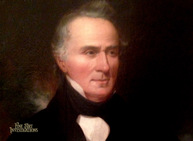Introduction
The third of the five family portraits depicted Judge Lewis Penn Witherspoon Balch (1787-1868). His grandson would marry a granddaughter of Julia Anna Marion Prosser (Mrs. Richard Bland Lee II) (1805-1886).
Subject

Balch was born on July 31, 1787, in Georgetown, District of Columbia, son of Reverend Stephen Bloomer Balch (1747-1833), founder and leader of Georgetown Presbyterian Church. The elder Balch studied with John Witherspoon (1723–1794), a president of Princeton College, a signator of the Declaration of Independence, and a member of Congress. L. W. P. Balch, of course, attended Princeton, graduating in 1806. He then studied law in Frederick, Maryland, under Roger B. Taney. Taney would become the fifth Chief Justice of the Supreme Court and infamous for his decision in the Dred Scott case.
On March 14, 1811, Balch married Elizabeth Wever (1790-1874). By 1812, they lived in Leesburg, Virginia, where Lewis practiced law and was a member of the Loudon County Militia. Their first child was named for his father. Eleven more children followed, but only six lived past childhood. The family numbered seven when they moved to Frederick, Maryland about 1830.((John W. Jordan, Colonial And Revolutionary Families Of Pennsylvania (Genealogical Publishing Com, 2004), 136; United States Census Bureau, Fourth Census of the United States, 1820, Leesburg, Loudoun, Virginia, NARA Roll: M33_137, page 3, last line; Thomas Willing Balch, Balch Genealogica, (Allen, Lane and Scott, 1907), 212, 219.))
Balch did not inherit the racist views of his legal mentor, Taney. In 1834, he freed his 22 slaves and took them to Baltimore. He “offered to send [them] to Liberia at his own expense.” The merchants of Baltimore “sold him what was necessary to fit out these twenty two Negroes for the voyage to Liberia at cost price.” Even at cost, Balch spent $1,500, or about $40,000 today, to repatriate his former slaves. A biographer wrote in an 1897 family history that Lewis Penn Witherspoon Balch “impoverished himself” by acting upon his convictions.((United States Census Bureau, Fifth Census of the United States, 1830, Frederick, Maryland; NARA Roll: M19_57, page 107, line 14; United States Census Bureau, Sixth Census of the United States, 1840, Frederick, Frederick, Maryland, NARA Roll:165_113, page 16, line 10; United States Census Bureau, Seventh Census of the United States, 1850, Jefferson County, Virginia, NARA Roll M432, page 75, lines 4-14; United States Census Bureau, Eighth Census of the United States, 1860, Charlestown, Jefferson County, West Virginia, NARA Roll: M653_1355, page 7, lines 32-36; Galusha Burchard Balch, Genealogy of the Balch Families in America (E. Putnam., 1897), 458.)) This may explain an entry Balch later wrote in his diary:
Jany 27 1842 This day I received…a commission of deputy Atty Gen for Frederick County in place of James Raymond Esq resigned. The office is worth perhaps $1500 per annum but may be the means of increasing my other professional business. Bless the Lord Oh my soul and all that is within me bless his holy name.((Thomas Willing Balch, op. cit., 215))
The year 1850 found the Balchs in Charleston, Virginia. When Civil War split the state, Charleston became part of West Virginia.
So strong a Union supporter was Balch that he cheered federal forces near his home even as “bullets were flying thick.” Following the war, he was appointed a state circuit judge for the northeastern counties of West Virginia. Hedied in Leesburg in 1868.((Ibid.,218; J. E. Norris, History of the Lower Shenandoah Valley Counties of Frederick, Berkeley, Jefferson and Clarke: Their Early Settlement and Progress to the Present Time; Geological Features; a Description of Their Historic and Interesting Localities; Cities, Towns and Villages; Portraits of Some of the Prominent Men, and Biographies of Many of the Representative Citizens (A. Warner & Company, 1890), 295. Galusha Burchard Balch, op. cit.))
Date
Given his birth date of 1787, his obvious maturity, his collar height, rolled jacket collar, and quiff, the portrait was probably painted between 1835 and 1845.
Region
From his whereabouts in public records, Balch’s portrait should have been painted in Frederick, Maryland, or Charleston, West Virginia. His personal diary, however, recorded travels outside the southern states. In 1839, he attended the wedding of his son, the Reverend Lewis Penn Witherspoon Balch, Jr. (1814-1875), at St. Bartholomew’s Episcopal Church, in New York City. The younger L. P. W. Balch wed Anna Jay (1813-1849), granddaughter of the first Supreme Court Justice John Jay (1745–1829), and daughter of William Jay (1789-1858), a founder of the American Antislavery Society. Balch was in New York City again for the Christmas and New Year holidays in 1843.((Thomas Willing Balch, 215-216.))
Artist
But the most probable place where Balch’s portrait was painted was the area around Baltimore, Maryland. Portrait artists working thee in the mid-1830s to 1840s were William Edward West (1788-1857), Oliver Tarbell Eddy (1799-1868), Alfred Jacob Miller (1810-1874), and Matthew Henry Wilson (1814- 1892). Eddy’s style was more naive; Miller, best known for his western scenes, used looser brushstrokes; and Wilson’s style was terse.
Stylistically, the portrait of Lewis Penn Witherspoon Balch somewhat fit into West’s oeuvre, with its powerful pose, similar palette, highlights and shadows. Again, attempts to vet the attribution proved futile. I am not entirely comfortable with the attribution. If you have a better sense of the artist, please let me know.

Oil on Canvas, 30 x 25 inchesPrivate Collection

Oil on Canvas, 30 x 25 inches Annapolis Art Collection1545_1196
Conclusion
A grandson of the judge who nearly impoverished himself to give full independence to 22 enslaved human beings would marry Mary Elizabeth Lee, a third cousin of Robert E. Lee whom W. E. West portrayed. The life of Mary Elizabeth Lee is told in another Stories Behind the Portraits.

